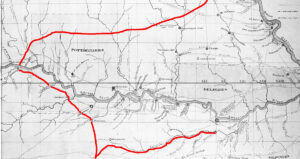
WESTERNMOST ROUTE OF THE UNDERGROUND RAILROAD
 The westernmost route of the Lane Trail began at Lawrence and headed south to the Wakarusa River where “the fighting preacher” John E. Stewart ran a station with his wife.
The westernmost route of the Lane Trail began at Lawrence and headed south to the Wakarusa River where “the fighting preacher” John E. Stewart ran a station with his wife.
From the Stewart’s, fugitives traveled west on the south side of the Wakarusa to Bloomington. From there they proceeded to Dr. Sabin’s cabin near Auburn. At that point they either went northwest to Mission Creek and Wabaunsee or southwest to the Harvey Settlement.
Activity on the Kansas Underground Railroad escalated in 1857 after the Dred Scott Decision and when the border war had subsided in the Kaw valley. Slaves escaping from Missouri, Arkansas and Texas were the primary “passengers”. The routes taken between safe houses fluctuated when participants came under suspicion or when a particular road was closely watched. Documentation exists indicating that stations at Auburn, Wakarusa, Lawrence and southern Lyon County fed stations in Wabaunsee County. After passing through Wabaunsee County, stations existed at Louisville, Manhattan, Juniata, and east of Centralia. Fugitives eventually met up with the main branch of the Lane Trail near the Nebraska border.
THE LANE TRAIL
After the sacking of Lawrence and the arrest and imprisonment of Free-State leaders at the end of May 1856, the Free-State cause was in danger of collapse. A national effort to organize aid for Kansas in the North was launched. ‘Kansas Committees’ were formed in thirteen states as well as a national coordinating group based in Chicago. Eli Thayer and other members of the New England Emigrant Aid Society were officers of the national committee.
James Lane, who was in Washington during the sacking of Lawrence, and other free-state leaders not arrested, spoke before rallies in Chicago, Detroit and other cities in the North. Lane’s performance in Chicago, before thousands of sympathizers, inspired contributions and enrollment in the cause. A vanguard group of seventy-eight free-state emigrants who signed up at the Chicago rally to go to the territory were turned back on June 20th by pro-slavery forces when they reached the border by steamboat via the Missouri.
This was the beginning of the blockade that forced free-state emigrants to take an overland route across Iowa, through the southeast corner of Nebraska to the northern Kansas border. Stating in early July, James Lane led an initial company of some 200 men across Iowa to Nebraska City, arriving there at the end of July. This is where the ‘trailblazing’ took place and where the terms “Lane’s Expedition”, Lane’s Party”, “Lane’s Army” and “Lane’s Trail” came into use in the press, and hence popular usage. The trail had not been laid out from the Nebraska/Kansas border to Topeka until Dr. J.P. Root, and A. A. Jameson, a committee of two sent by the Kansas Central Committee, accomplished the task in the first few weeks of July. Jameson’s brother, S.V. Jameson, had been appointed to the committee but apparently did not participate.
Meanwhile, more emigrant parties from Wisconsin, Illinois, Ohio and elsewhere totaling some 400 men women and children followed the route across Iowa ending up at Tabor, Iowa. Although bonafide settlers, they too were called “Lane’s Army”.
The leadership of the National Kansas Committee decided that Jim Lane had to be removed from his leadership position because he was perceived as a military man leading an armed insurgency into the territory. The Free-State position was to not engage Federal troops because this would be considered treason and very bad politically during free-state John Fremont’s bid for the presidency. Lane threatened to commit suicide but eventually agreed with the reasoning. Leadership of the company was given to Mr. Dickey of Lawrence. Lane entered the territory under an alias in a small group that included John Brown. After an amazing non-stop ride he entered Lawrence alone: everyone else had collapsed from exhaustion along the way.
Under the leadership of Dickey the rest of the company crossed into Kansas on the 7th of August. Groups split off to settle in Plymouth, Lexington, Holton and Topeka.
There are many first person accounts of the trip from Tabor and Nebraska City into Kansas.
As Shalor Eldridge wrote;
“For material regarding the make-up of these companies, the names of conductors, points of organization, etc., see Kansas Historical Collections, vol. 8, p. 308, 309 text and footnote. While some things have been written about the party to come through Iowa to Kansas, known as ‘Lane’s army of the North,’ no general story has yet been told.
There is abundant material to be found on the subject. The letters of Hyatt and others connected with the National Kansas Committee; the Webb scrapbooks; the executive minutes of Gov. John W. Geary, published in Kansas Historical Collections, vol. 4; scattering stories of different members of this emigration movement published in various volumes of the Historical Collections and in the Andreas History of Kansas, all form primary and secondary sources from which a valuable paper on this little-known phase of Kansas history could be compiled.”
– Shalor Eldridge, Early Days In Kansas.
